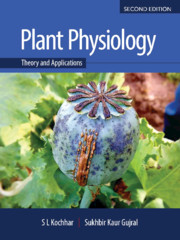Book contents
- Frontmatter
- Contents
- Foreword
- Preface to the Second Edition
- Preface to the First Edition
- Acknowledgements
- Some Common Abbreviations used in the Text
- Abbreviations for Units
- Unit I Water and Mineral Translocation in Plants
- Unit II Metabolism and Bioenergetics
- Unit III Growth and Development
- Unit IV Physiological Stress and Secondary Metabolites – Their Role in Metabolism
- Unit V Crop Physiology – An Innovative Approach
- Unit VI Breakthroughs in Plant Physiology
- Unit VII Some Experimental Exercises
- Glossary
- References
- Index
- Colour Plates
Chapter 5 - Concepts of Metabolism
Published online by Cambridge University Press: 12 May 2020
- Frontmatter
- Contents
- Foreword
- Preface to the Second Edition
- Preface to the First Edition
- Acknowledgements
- Some Common Abbreviations used in the Text
- Abbreviations for Units
- Unit I Water and Mineral Translocation in Plants
- Unit II Metabolism and Bioenergetics
- Unit III Growth and Development
- Unit IV Physiological Stress and Secondary Metabolites – Their Role in Metabolism
- Unit V Crop Physiology – An Innovative Approach
- Unit VI Breakthroughs in Plant Physiology
- Unit VII Some Experimental Exercises
- Glossary
- References
- Index
- Colour Plates
Summary
Metabolism
Plants can synthesize most of the organic matter on earth by assimilating inorganic elements (carbon and nitrogen), from the environment into organic molecules, driven by energy from sunlight. Every year, plants incorporate through photosynthesis nearly 100 billion metric tons of carbon, which is approximately 15 per cent of the total carbon dioxide (CO2) present in the atmosphere. Respiration by plants and heterotrophic organisms converts the same amount of carbon present in organic compounds back into CO2. These processes are important not only for the plants, but also for animals, fungi, and bacteria, which receive their carbon and nitrogen solely from organic compounds and thus completely rely on plant sources to obtain nutrition. Plants acquire the major elements (C, H, O and N) chiefly as carbon dioxide, water, and nitrate along with other minerals elements in lesser amounts from the soil. This mode of nutrition, as obtained from inorganic compounds, is called autotrophy and photosynthetic bacteria, green algae, and vascular plants are examples of autotrophs. On the other hand, for those organisms that get their carbon and nitrogen exclusively from organic compounds, their mode of nutrition is called heterotrophy. Multicellular animals, carnivorous plants, fungi, and most of the microorganisms are heterotrophs. Carbon, oxygen, and nitrogen are continuously recycled between the heterotrophs and autotrophs present in the biosphere, using the sun's energy as the driving force and this recycling process depends on a proper balance between their activites. These cycles of matter are controlled by huge energy flows within the biosphere, starting with the harvesting of sun's energy by photoautotrophs and its utilization in producing organic compounds including carbohydrates, which are then consumed as sources of energy by heterotrophs. Although carbon, oxygen, and nitrogen keep on recycling constantly, a part of the energy involved is being continuously changed into non-usable form such as heat.
Metabolism can be defined as ‘the sum total of all the chemical reactions occurring in a cell or organism’, and takes place through a sequence of reactions catalyzed by enzymes, thus constituting metabolic pathways and the metabolic intermediates are known as metabolites. Every successive step of the metabolic pathway results in a small and specific chemical change (elimination/inclusion/shifting of a specific molecule or the functional group).
- Type
- Chapter
- Information
- Plant PhysiologyTheory and Applications, pp. 153 - 167Publisher: Cambridge University PressPrint publication year: 2020



